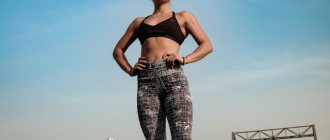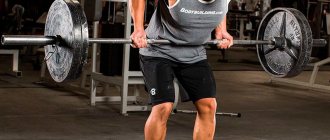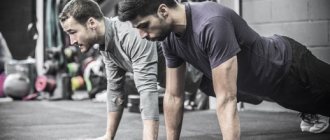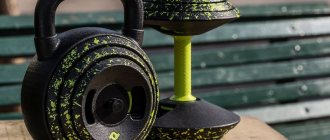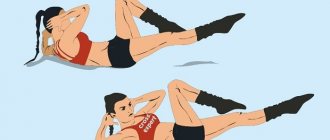The exercise “walking on the buttocks” appeared and became popular about half a century ago. In the 70s, it was included in health-improving gymnastics and was advised to be performed not only by those who wanted to work out their buttocks, but also by those who had intestinal problems. Today we at invme will talk about whether this exercise is effective and what effect it has on the body.
The exercise “walking on the buttocks” appeared and became popular about half a century ago.
What kind of exercise is this?
Walking on the buttocks is an exercise aimed at the pelvic part of the body. People first started talking about this exercise in the early 70s. Then it was considered exclusively as one of the types of therapeutic training. And only a few decades later it became obvious that it has a beneficial effect not only on human health, but also helps strengthen the gluteal muscles.
Walking on the buttocks normalizes the functioning of the gastrointestinal tract, which greatly speeds up metabolism and promotes proper bowel function. In addition, the exercise helps not only to form beautiful and sculpted buttocks, but also gets rid of the so-called “orange peel” on the hips. Of course, this effect can be achieved if you perform the exercise regularly, and even better if you combine it with other physical activity and a balanced diet.
Contraindications
Despite the fact that walking on the fifth point is recommended for people of all age groups and different physical levels, there are some contraindications and restrictions. I will give the main ones:
For women, the first trimester of pregnancy. This is the most dangerous period, during which it is recommended to devote most of the time to rest and abstain from intense physical activity.
Another contraindication for the fair sex is the menstrual period. The main risk of such activities during menstrual periods may be endometrial detachment, which accompanies increased pressure on the abdominal cavity.
Abdominal and lumbar pain - with an illiterate approach, pain in the peritoneum and lumbar region may increase.
Who invented it?
The exercise was invented by Doctor of Medical Sciences Ivan Neumyvakin in the 70s. Neumyvakin is the author of many scientific works and popular books on the topics of treatment and human health. He believed that the initially correct functioning of the body depends on the state of the digestive tract. And the proper functioning of the intestines is greatly influenced by strong and developed gluteal muscles. That is why the doctor of science developed just such an exercise, which affects both the muscular component of the buttocks and the internal functioning of the body.
Feedback about this exercise
Elena, Pyatigorsk, 27 years old
“I found such classes difficult at first. But after a couple of weeks of working at home, I got quite used to it and started doing them every day, as advised. Within a month the effect was amazing – my butt tightened, I felt lightness in my lower back, I became more cheerful and cheerful!”
Oleg, Moscow, 35 years old
“A specialist recommended such classes when I came to him with problems in the “personal sphere.” I combined seated gluteal training with medication treatment - after a couple of weeks I noticed relief, it became easier to go to the toilet, and there was less pain in the lower abdomen.”
How to do the exercise?
How to walk on your butt correctly? There are several ways to perform the exercise correctly. Let's talk about the main ones.
Classical
Sit on the floor (preferably on a carpet), keeping your back straight. Bend your arms at the elbow and press them to your body. Keep your feet shoulder-width apart and tighten the muscles of your buttocks and thighs. Extend your left leg, transfer all your weight to it and move forward 5-10 cm, then do the same with your right leg. Then walk across the floor on your buttocks back and forth in a similar manner.
With slopes
Sit in the starting position, which is described in the classic version, tense your muscles and start moving with your left leg, while you also need to tilt your head to the left and move your arms to the right. Then repeat the same with the right leg and perform the same walking backwards.
With arms outstretched
Sit in the starting position, which is described in the classic version, tense your muscles and start moving with your left leg, while moving your hands behind your head. Move forward and then move backward.
The most difficult
You need to take a sitting position. Hold a liter bottle between your feet. Holding it between your legs, start moving forward about two meters. After this, turn your body to the right side and continue moving. Then turn your body to the left and move on. We recommend performing this method after you have learned the correct technique for walking on your buttocks.
Abdominal exercise
Starting position: sit on the floor or step platform, lift your legs off the floor, keeping them slightly bent at the knees. Stretch your arms in front of you, palms parallel to the floor, shoulder blades down. While performing this exercise, keep your abdominal muscles toned and do not relax. Start swinging your arms up and down with a small amplitude, as if hitting imaginary water with your palms.
How long to do: 3 sets of 30 seconds.
To enlighten you: 3 basic exercises for the inner thigh Read
Some tips
- Be sure to ensure that your back remains straight - there should be a 90-degree angle between your legs and back
- Do not move your arms, you can only use your arms to help yourself maintain balance, but do not forget that the point of the exercise is to ensure that the entire load is directed specifically at the pelvic muscles
- When you move forward, you should try to keep your leg suspended
- It is best to exercise in smooth pants to avoid blisters.
- Do not perform the exercise for too long without preparation. For starters, 15 repetitions 2-3 times will be enough.
- The main thing is not the number of repetitions or the time spent on the exercise, but the correct technique when performing it.
Do not perform the exercise for too long without preparation.
Taking the leg to the side
Starting position: get on all fours, hands directly under your shoulders. Keep your back straight without bending in the lumbar region. Take your right leg bent to the side, swinging parallel to the floor, and return it back without lowering your knee to the floor. Or a more complex option: add a small pulse at the top point, then lower your leg. Do the work with one leg first, then the other.
How much to do: 3 sets of 15 repetitions on each leg.
10-minute home workout for weight loss Read
Walking on your buttocks: benefits
Walking on the buttocks for women allows not only to acquire a toned body, but also prevents the development of some female diseases, relieves severe pain during menstruation and fights involuntary urination in older people. An even greater effect in the form of beautiful buttocks without cellulite can be achieved by using dumbbells during exercise. In addition, before starting the exercise, you can apply anti-cellulite cream to problem areas, which will increase the likelihood that you will forget about the “orange peel” forever. We have already talked about methods of combating cellulite and ways to prevent it. (linking)
This exercise is no less important for maintaining the health of men. Its frequent implementation can prevent the development of diseases such as prostatitis and prostate adenoma. Neumyvakin believed that all men should walk on their buttocks in order to use the muscles of the pelvic area, which are responsible for maintaining potency.
The benefits and harms of exercise
With regular and competent practice, this exercise will strengthen the gluteal muscles, eliminate a common aesthetic problem in women, “orange peel” (cellulite), and also cope with the following conditions:
- Haemorrhoids.
- Constipation.
- Rectal prolapse.
- Adenoma in men.
- Swelling in the legs.
- Enuresis.
Seated walking (hereinafter referred to as “buttocks”) is very often used for the prevention and treatment of gynecological diseases. It improves blood circulation in the pelvic organs, increases reproductive function, adhesions and urinary incontinence. It is often recommended for women to prevent endometriosis, and for men - adenoma.
Of course, if done incorrectly, you can not only waste time, but also cause some harm to the body. With increased training intensity, skin chafing may occur, accompanied not only by hyperemia, but also by unwanted rashes.
Benefits for the stronger half
It is important for men to maintain masculine strength. This simple exercise will allow you to maintain potency for a long time. All the guys who do this exercise unanimously note that their erection time has increased. An active lifestyle stimulates blood flow to the penis.
What does walking on the floor do to get rid of male diseases? Men know how dangerous prostatitis is. The disease begins with stagnation of fluid, as well as venous blood in the prostate. But gluteal walking will help to engage all the nerve endings, as well as the venous tubules in the pelvic area.
Also, during movement, the prostate is massaged and the cruciate pelvic muscles are strengthened. In addition, gymnastics on the floor helps get rid of congestion, enuresis, and constipation.
Impact on the figure
An important question for women who plan to exercise not for therapeutic and prophylactic purposes, but for figure correction: will such walking help to lose weight and improve the proportions of the lower body?
https://www.youtube.com/watch?v=9UTvdxB_kq0
Yes, this exercise is definitely useful. Walking while sitting increases blood circulation, has a beneficial effect on the condition of the skin and overall muscle tone. But to significantly burn fat or develop muscles in the lower body, more intense physical activity is required.
Therefore, if your main goal is figure correction, you can use it as a warm-up, focusing on doing squats, swings or other exercises for the legs and buttocks. Don’t forget about aerobic training, which will strengthen the cardiovascular system and speed up metabolism, which is also important when losing weight.
Warm up before starting
Before performing the exercise, you should warm up in order to prepare the body for unusual loads.
Suitable in this case:
- circular movements of the head, shoulders, legs;
- bends to the sides.
Breathing is also important in warming up. Before exercising, take a deep breath and exhale slowly. Do this about 5-7 times. This will saturate the muscle tissue with oxygen, as well as reduce the production of lactic acid, which contributes to the appearance of pain after unusual exercise.
Then you need to stretch the gluteal muscles in order to prepare as much as possible for the main exercise:
- Take a lying position. Bend your right leg at the knee.
- Use your hand to pull it towards your chest.
- Stay in this position for 30 seconds.
- Then repeat the exercise with the other leg.
- After this, pull both legs towards your chest.
For effectiveness, you can do stretching with your leg extended. The sequence of actions is similar to the previous exercise.
That's it, when the warm-up is done, you can start walking on your buttocks.
Execution order (program)
You can perform walking either on its own or as part of a larger workout. The second option is more preferable.
Procedure for performing the exercise:
- Warm-up (how to do it will be described in detail at the end of the article).
- Stretching – special attention should be paid to the ligaments of the legs and back.
- Cardio elements – at least 15 minutes.
- Any simple leg exercises (plank, scissors, bicycle), exercises with or without weights.
- And only after this is it recommended to start walking.
- You need to overcome at least 5 meters on your buttocks, alternating the load with rest for 1-2 minutes. Do at least 3-4 approaches.
- After the complex, you can do a plank or other general strengthening exercise.
You can perform one technique or combine them. Ideally, you should complete all five options.
